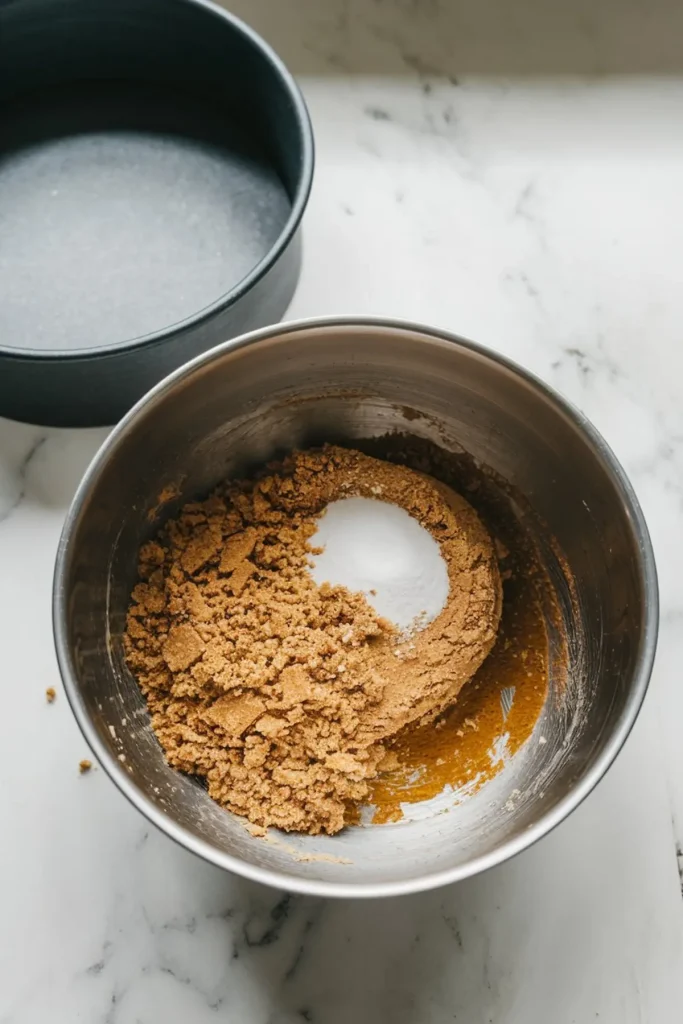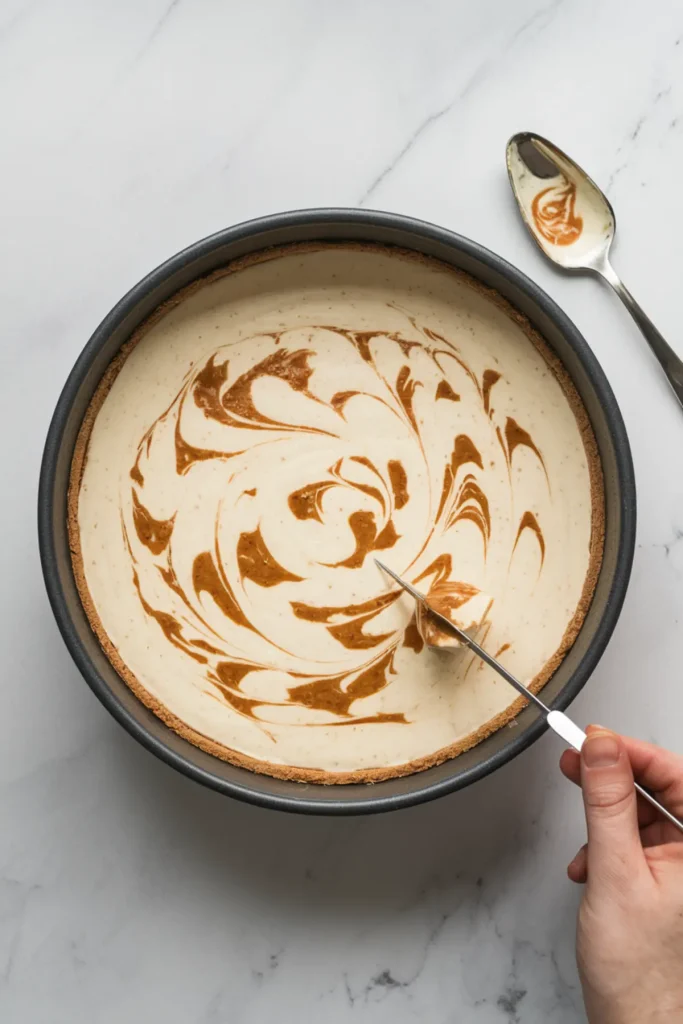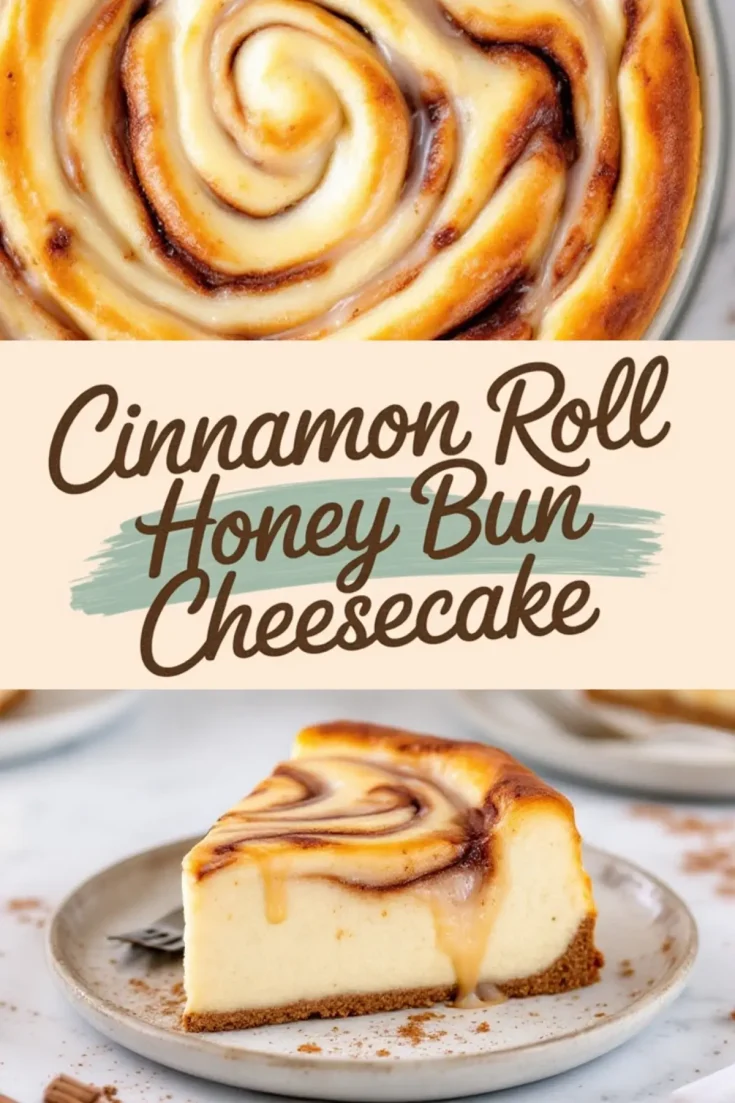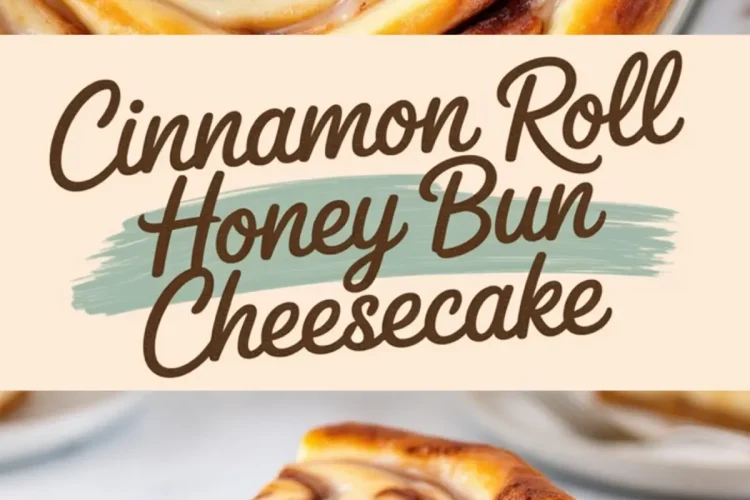There’s a quiet moment before you slice into a chilled cheesecake, where all you see is that pale surface—smooth, steady, giving nothing away. But then your knife cuts through, and there it is: the swirl. Golden brown sugar, cinnamon, soft ribbons baked into vanilla cream.
This Cinnamon Roll Honeybun Cheesecake doesn’t ask for your attention. It just holds it.
If you’ve ever stood in front of a bakery case debating between a honeybun or a thick wedge of cheesecake, this recipe spares you the decision. Here’s how to bring both together in a way that’s practical, beautiful, and full of flavor.

Graham Cracker Crust with Cinnamon Sugar Warmth
This starts where many good things do—graham crackers, sugar, melted butter. But that pinch of cinnamon? It matters more than you’d expect. The crust becomes more than just structure. It sets the tone.


You’ll press the crumbs into a springform pan until every corner feels firm and flat. That matters for cutting later. I like to run the bottom of a heavy glass over the surface until I feel no grit. Then, while the oven preheats, you bake just enough to seal it all in place.
I’ve found that even ten minutes in the oven gives the crust an edge—a little toast, a little snap. It anchors the softness above it without crumbling.
Smooth Vanilla Cheesecake with Cinnamon Roll Swirls

The filling leans classic. Cream cheese, sugar, eggs, sour cream, and a splash of vanilla. It’s creamy but not too rich, sweet but not heavy. This is where I slow down. Room temperature ingredients matter more than you think. Cold cream cheese clumps. Cold eggs won’t mix in right. Let them sit. They’ll reward your patience.
Now the swirl. It’s not just a pretty trick—it’s flavor distribution. Brown sugar, melted butter, cinnamon, and just a little flour to hold it together. The swirl mixture should feel like cinnamon paste, not sauce. That way, it floats where it should instead of sinking.
I like to pour half the batter first, then drop spoonfuls of the swirl. Then pour the rest and repeat. Don’t over-swirl. Use a butter knife or skewer and pull gently in slow figure-eights. You want ribbons, not mud.
Baking and Cooling Without Cracks or Fuss
Bake it low and slow. I usually check around 55 minutes, then again at 60. The edges should be set, and the center should wobble like your belly after a good laugh. That’s your signal to turn off the oven.


Then—this part is important—let it sit. Keep the oven door open a crack and walk away for an hour. That gentle cool-down helps prevent big cracks from sudden temperature changes. After that, refrigerate uncovered overnight. It needs the cold to fully set.
I’ve skipped water baths for this recipe. It holds up fine without it, especially if your oven is steady. But if your bakes tend to crack, wrapping the pan in foil and using a water bath won’t hurt.
Honey Glaze That Tastes Like a Bakery Counter
This glaze is the part that turns this cheesecake into something more. Honey, cream, butter—stirred just until it bubbles gently. When it cools, it thickens slightly, giving you that shiny finish that drips slow but doesn’t run wild.
I wait until the cheesecake is cold before I spoon it on. If you want clean slices, glaze right before serving. If you like sticky edges and gooey bites, glaze early and let it chill together. There’s no wrong way here.
Once, I served this to a friend who thought it was a cinnamon bun cake at first glance. By the second bite, he looked up and said, “Wait. This is cheesecake?” That’s when I knew this recipe was something I’d make again.
How to Serve and Store Cinnamon Roll Cheesecake
This cheesecake holds its shape well and slices clean when fully chilled. Use a sharp knife, and wipe it between cuts. If I’m serving this for brunch, I bring it out about fifteen minutes before slicing. It takes the chill off and softens the texture just enough.
For storing, cover tightly and refrigerate for up to five days. If you’re planning ahead, skip the glaze until right before serving. It helps the texture stay firm. You can even freeze the whole cheesecake without the glaze. Just wrap it tightly in plastic and foil, and freeze for up to a month. Thaw overnight in the fridge, then glaze fresh.
I’ve even used leftover slices as the base for a cinnamon roll cheesecake trifle. Sounds wild, but it works. If you’ve tried my Caramel Pecan Cinnamon Rolls, you’ll know how much I value a warm cinnamon dessert. This cheesecake brings that same comfort with a cool, creamy edge.
Save This Recipe and Let’s Talk Cheesecake

Pin this Cinnamon Roll Honeybun Cheesecake so you don’t forget it. It’s the kind of dessert that works year-round—birthday, brunch, holiday, or just a regular Thursday. If you try it, tell me how it went. Did your swirl hold up? Did someone mistake it for something else? Leave a comment, ask a question, or just say hi. I’m always reading.
Craving More Swirled Desserts?
If this cheesecake hits your cinnamon spot, you’ll probably love my Cinnamon Babka or these quirky Cookie Monster Cinnamon Rolls—blue, fun, and surprisingly good. And for those days when only Nutella will do, Nutella Cinnamon Rolls always deliver.
Cinnamon Roll Honeybun Cheesecake Recipe

A buttery graham cracker crust supports a rich, creamy vanilla cheesecake with ribbons of cinnamon sugar swirled throughout. The top gets finished with a simple honey glaze for a sweet, sticky finish reminiscent of a classic honeybun. This recipe combines the texture of baked cheesecake with the warm spice of a cinnamon roll in one comforting dessert.
Ingredients
- FOR THE CRUST
- 1 ½ cups graham cracker crumbs
- ¼ cup granulated sugar
- ½ teaspoon cinnamon
- 6 tablespoons unsalted butter, melted
- FOR THE CHEESECAKE FILLING
- 24 oz cream cheese, softened
- 1 cup granulated sugar
- 3 large eggs, room temperature
- 1 teaspoon vanilla extract
- ¾ cup sour cream
- ¼ cup heavy cream
- FOR THE CINNAMON SWIRL
- ⅓ cup brown sugar, packed
- 1 tablespoon ground cinnamon
- 3 tablespoons unsalted butter, melted
- 1 tablespoon all-purpose flour
- FOR THE HONEY GLAZE
- ¼ cup honey
- 2 tablespoons heavy cream
- 1 tablespoon butter
Instructions
- PREPARE THE CRUST: Preheat oven to 325°F (160°C). In a medium bowl, stir together graham cracker crumbs, sugar, and cinnamon. Add melted butter and mix until the texture resembles wet sand. Press the mixture evenly into the bottom of a 9-inch springform pan using the bottom of a glass or measuring cup. Bake for 10 minutes, then set aside to cool slightly.
- MAKE THE CINNAMON SWIRL: In a small bowl, combine brown sugar, cinnamon, flour, and melted butter. Mix until smooth and thick. Set aside while you prepare the cheesecake filling.
- MIX THE CHEESECAKE FILLING: In a large mixing bowl, beat cream cheese and sugar on medium speed until creamy and smooth, about 2 minutes. Add eggs one at a time, mixing until just incorporated after each addition. Stir in vanilla, sour cream, and heavy cream by hand until the mixture is smooth, taking care not to overmix.
- ASSEMBLE THE CHEESECAKE: Pour half of the cheesecake batter over the prepared crust. Drop spoonfuls of half the cinnamon swirl mixture over the batter and gently swirl using a skewer or butter knife. Repeat with the remaining cheesecake batter and remaining swirl mixture, swirling the top again. Place the springform pan on a baking sheet and bake for 55 to 65 minutes, or until the center is mostly set with a slight jiggle.
- COOL AND CHILL: Turn off the oven and crack the door open. Let the cheesecake cool inside the oven for 1 hour. Remove, then refrigerate uncovered for at least 6 hours or overnight until fully chilled and set.
- MAKE THE HONEY GLAZE: In a small saucepan over low heat, combine honey, heavy cream, and butter. Stir continuously until the mixture is smooth and starts to bubble gently. Remove from heat and allow to cool slightly before drizzling over the cold cheesecake before serving.
Notes
This cheesecake benefits from attention to detail at every stage—from ingredient prep to final chilling. Here’s a deeper breakdown of tips and insights to help ensure a successful result.
Ingredient Temperature Matters: Let all dairy ingredients come fully to room temperature before mixing. This includes cream cheese, sour cream, heavy cream, and eggs. Room temperature ingredients blend together more easily and help create a smooth, lump-free batter. Cold cream cheese in particular tends to clump and resist mixing, which can result in a gritty texture. Taking the extra time for proper tempering also reduces the amount of mixing needed, which helps avoid incorporating too much air.
Crust Consistency and Compression: The crust should feel like damp sand—moist enough to hold its shape when pressed but not greasy. Mixing the melted butter thoroughly into the crumbs ensures even moisture and prevents dry pockets. Use a flat-bottomed glass or measuring cup to press the crust firmly into the pan. A well-packed crust will hold together better after slicing and provide a sturdy foundation for the rich filling. If you like your crust slightly thicker or want it to go up the sides, feel free to increase the crumb mixture by 25–30%.
Swirl Technique: The cinnamon swirl mixture should be thick but spreadable, like a paste. Adding a small amount of flour stabilizes it so it doesn’t sink or run through the batter. When swirling, use a skewer or thin knife and gently drag it in figure-eight motions through the top layer of batter. Avoid over-swiping, as this can blend the swirl mixture too much into the batter, causing you to lose that beautiful marbled look. You can also vary the swirl depth—some closer to the surface and others reaching deeper—to create more dynamic layers.
Mixing the Filling: Overmixing is a common pitfall in cheesecake recipes. Use a paddle attachment if using a stand mixer, and beat only until each ingredient is incorporated. After the eggs go in, switch to low speed or finish mixing by hand. The batter should be creamy and smooth, not airy. Air pockets introduced during mixing can expand during baking and cause cracks or an uneven rise.
Baking Strategy: Bake the cheesecake on the middle rack, placing the springform pan on a baking sheet to catch any butter drips from the crust and to help insulate the bottom for even baking. A traditional water bath isn’t required here, but if your oven runs hot or you’re prone to cracks, you can wrap the springform pan in foil and bake it in a hot water bath to create a more humid environment.
Doneness Check: Begin checking for doneness around the 55-minute mark. The edges should look set while the center should still have a gentle wobble when the pan is nudged. Do not wait for the center to be completely firm—that can mean it’s overbaked. Cheesecakes continue to cook from residual heat after the oven is turned off.
Cooling and Chilling: Letting the cheesecake cool gradually in the oven with the door slightly open helps prevent large cracks from forming due to temperature shock. After an hour, move it to the refrigerator uncovered and let it chill for a minimum of 6 hours, but ideally overnight. Cover with plastic wrap once fully cooled to avoid condensation on the surface.
Glazing Tips: The honey glaze is meant to mimic the sticky-sweet topping of a classic honeybun. It only takes a few minutes to make and adds a polished finish. Let it cool just enough so it thickens slightly before drizzling over the cheesecake. If you prefer a neater presentation, spoon the glaze just before serving to avoid spreading during storage. You can also refrigerate any extra glaze and rewarm slightly before using again.
Nutrition Information
Yield
12Serving Size
1Amount Per Serving Calories 575Total Fat 39gSaturated Fat 22gTrans Fat 0gUnsaturated Fat 13gCholesterol 152mgSodium 307mgCarbohydrates 52gFiber 1gSugar 43gProtein 7g

